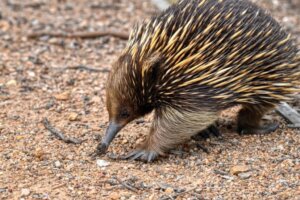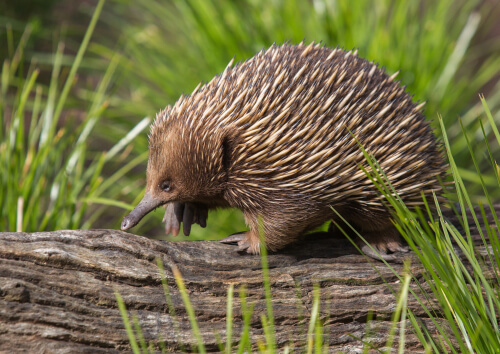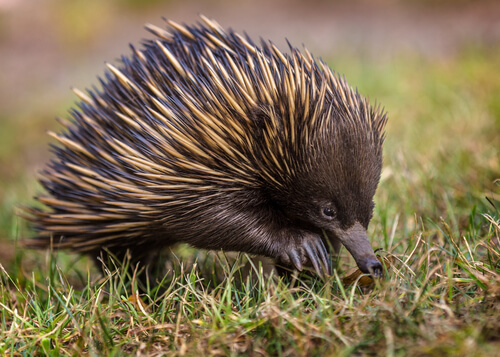The Echidna Is One of the Strangest Mammals in the World


Written and verified by the psychologist Sara González Juárez
You’ve probably heard about the oddities of the platypus, that venomous, egg-laying, suckling animal. But, if you thought that it was the strangest animal on the face of the Earth, then you haven’t heard of the echidna. Many mistake it for a hedgehog because of the spikes that grow on its back, but it’s far removed from this particular animal.
What secrets does this animal hide? We’re sure that many will amaze you! Let’s get to know this animal, also called the spiny anteater, a little better, because it packs so much into such a small body.
Meet the echidna

Echidnas are the only members of their taxonomic family (Tachyglossidae). They’re mammals that inhabit the islands of the Australian continent, such as New Guinea, Salawatu, and Tasmania. Two genera are currently recognized:
- Tachyglossus: Short-snouted or Australian echidnas. The only member of this genus is the common echidna (Tachyglossus aculeatus).
- Zaglossus: Long-snouted or New Guinea echidnas. Here we find Attenborough’s Zaglossus (Zaglossus attenboroughi), Barton’s Zaglossus (Zaglossus bartoni) and the common or Bruijn’s Zaglossus (Zaglossus bruijni).
Echidnas aren’t any more than 45 centimeters (2o inches) long and are covered with dense fur. Their back has long barbs that protect them from predators. They usually weigh from 2 to 7 kilograms (4.4 to 15.4 pounds), depending on the species and sex (males are larger than females).
Their diet consists mainly of insects such as earthworms, termites, and ants. Because of this, its jaw isn’t very developed, and it resembles that of an anteater without any teeth.
Curiosities about the echidna
In cases like the echidna, the best way to delve into their biology is through the curiosities they hide. In the following sections, we’ll bring you the most incredible ones about this animal.
Its tongue measures 20 centimeters
Since it needs to get insects out of small holes, such as anthills and termite mounds, its 20 cm (8 inch) length is such that it can catch several insects at the same time. In addition to being long, it’s sticky, which makes it easier for prey to stick to it.
The horny spines located on the palate are responsible for crushing insects, since echidnas have no teeth.
They’re great diggers
They use all 4 legs to dig tunnels and holes to hide in. It’s also common for them to use their long claws to dig up prey such as worms. The second toe of the hind limbs is longer than the rest and the echidna uses it for scratching and grooming.
Marsupials, oviparous and mammalian
Echidna reproduction is a veritable conglomerate of curiosities and oddities. The female lays only one egg per year, which she rolls to her marsupium. There the incubation takes place and, when the little echidna hatches, it uses its tiny claws to cling to the mother’s hair inside the pouch.
Females have no nipples, so the young will feed on the milk secreted by the mother’s own skin through specific glands.
At about 53 days, which is when the little echidna’s quills begin to emerge, the mother digs a burrow and leaves it there. She’ll feed it every 5-10 days until, at 7 months of age, it’s able to fend for itself.
The penis of the male echidna
Another incredible feature of echidnas is the penile anatomy of the males. In a trait closer to reptiles than mammals, this organ has 4 outlets instead of one. Not all glands are functional at the same time, but only half of them fertilize the female when mating occurs.
They have spurs, but no venom
Like platypuses, echidna have spurs behind the knee joint. However, unlike the former, they don’t secrete venom through them. To date, the function of this part of their anatomy is unknown.
The strange mating ritual of the echidna
The behavior of this animal isn’t free of curiosities either. The courtship performed by the male is strange, to say the least, and consists of the following steps:
- Males form a caravan behind the female: Up to 10 of them have been seen behind a female. This can go on for weeks.
- If she’s willing, she’ll secrete sex pheromones to indicate to her suitors that she can mate. Otherwise, she’ll retract into a ball of spikes.
- The female lies on the ground and the males dig around her. They form a kind of trench in which they’ll fight each other until one manages to get behind the female.
- The winning male caresses the female with his quills until she’s ready to mate.
They have electroreception

Although this sense is more useful to the marine animals that have it (water is a better conductor of electricity than air), the echidna makes good use of it. The long-snouted echidna has 2000 electroreceptors in its mouth, while the short-snouted echidna has only 400.
The short-snouted echidna can only use this sense on rainy days, when it can detect worms in damp soil.
As you can see, the echidna is a most peculiar animal. Considered by some as an animal close to living fossils (because of its similarities to reptiles), it’s still a group of peculiarities that leave no one indifferent. So, if you have been surprised by this animal, we encourage you to continue investigating, as there are surely more facts still to find out.
You’ve probably heard about the oddities of the platypus, that venomous, egg-laying, suckling animal. But, if you thought that it was the strangest animal on the face of the Earth, then you haven’t heard of the echidna. Many mistake it for a hedgehog because of the spikes that grow on its back, but it’s far removed from this particular animal.
What secrets does this animal hide? We’re sure that many will amaze you! Let’s get to know this animal, also called the spiny anteater, a little better, because it packs so much into such a small body.
Meet the echidna

Echidnas are the only members of their taxonomic family (Tachyglossidae). They’re mammals that inhabit the islands of the Australian continent, such as New Guinea, Salawatu, and Tasmania. Two genera are currently recognized:
- Tachyglossus: Short-snouted or Australian echidnas. The only member of this genus is the common echidna (Tachyglossus aculeatus).
- Zaglossus: Long-snouted or New Guinea echidnas. Here we find Attenborough’s Zaglossus (Zaglossus attenboroughi), Barton’s Zaglossus (Zaglossus bartoni) and the common or Bruijn’s Zaglossus (Zaglossus bruijni).
Echidnas aren’t any more than 45 centimeters (2o inches) long and are covered with dense fur. Their back has long barbs that protect them from predators. They usually weigh from 2 to 7 kilograms (4.4 to 15.4 pounds), depending on the species and sex (males are larger than females).
Their diet consists mainly of insects such as earthworms, termites, and ants. Because of this, its jaw isn’t very developed, and it resembles that of an anteater without any teeth.
Curiosities about the echidna
In cases like the echidna, the best way to delve into their biology is through the curiosities they hide. In the following sections, we’ll bring you the most incredible ones about this animal.
Its tongue measures 20 centimeters
Since it needs to get insects out of small holes, such as anthills and termite mounds, its 20 cm (8 inch) length is such that it can catch several insects at the same time. In addition to being long, it’s sticky, which makes it easier for prey to stick to it.
The horny spines located on the palate are responsible for crushing insects, since echidnas have no teeth.
They’re great diggers
They use all 4 legs to dig tunnels and holes to hide in. It’s also common for them to use their long claws to dig up prey such as worms. The second toe of the hind limbs is longer than the rest and the echidna uses it for scratching and grooming.
Marsupials, oviparous and mammalian
Echidna reproduction is a veritable conglomerate of curiosities and oddities. The female lays only one egg per year, which she rolls to her marsupium. There the incubation takes place and, when the little echidna hatches, it uses its tiny claws to cling to the mother’s hair inside the pouch.
Females have no nipples, so the young will feed on the milk secreted by the mother’s own skin through specific glands.
At about 53 days, which is when the little echidna’s quills begin to emerge, the mother digs a burrow and leaves it there. She’ll feed it every 5-10 days until, at 7 months of age, it’s able to fend for itself.
The penis of the male echidna
Another incredible feature of echidnas is the penile anatomy of the males. In a trait closer to reptiles than mammals, this organ has 4 outlets instead of one. Not all glands are functional at the same time, but only half of them fertilize the female when mating occurs.
They have spurs, but no venom
Like platypuses, echidna have spurs behind the knee joint. However, unlike the former, they don’t secrete venom through them. To date, the function of this part of their anatomy is unknown.
The strange mating ritual of the echidna
The behavior of this animal isn’t free of curiosities either. The courtship performed by the male is strange, to say the least, and consists of the following steps:
- Males form a caravan behind the female: Up to 10 of them have been seen behind a female. This can go on for weeks.
- If she’s willing, she’ll secrete sex pheromones to indicate to her suitors that she can mate. Otherwise, she’ll retract into a ball of spikes.
- The female lies on the ground and the males dig around her. They form a kind of trench in which they’ll fight each other until one manages to get behind the female.
- The winning male caresses the female with his quills until she’s ready to mate.
They have electroreception

Although this sense is more useful to the marine animals that have it (water is a better conductor of electricity than air), the echidna makes good use of it. The long-snouted echidna has 2000 electroreceptors in its mouth, while the short-snouted echidna has only 400.
The short-snouted echidna can only use this sense on rainy days, when it can detect worms in damp soil.
As you can see, the echidna is a most peculiar animal. Considered by some as an animal close to living fossils (because of its similarities to reptiles), it’s still a group of peculiarities that leave no one indifferent. So, if you have been surprised by this animal, we encourage you to continue investigating, as there are surely more facts still to find out.
All cited sources were thoroughly reviewed by our team to ensure their quality, reliability, currency, and validity. The bibliography of this article was considered reliable and of academic or scientific accuracy.
- Augee, M. L., Gooden, B., & Musser, A. (2006). Echidna: extraordinary egg-laying mammal. CSIRO publishing.
- Beard, L., & Grigg, G. C. (2000). Reproduction in the short-beaked echidna. In Proceedings of the Linnean Society of New South Wales (Vol. 122, pp. 89-99).
- Zhou, Y., Shearwin-Whyatt, L., Li, J., Song, Z., Hayakawa, T., Stevens, D., … & Zhang, G. (2021). Platypus and echidna genomes reveal mammalian biology and evolution. Nature, 592(7856), 756-762.
- Rismiller, P. D., & Seymour, R. S. (1991). The echidna. Scientific American, 264(2), 96-103.
This text is provided for informational purposes only and does not replace consultation with a professional. If in doubt, consult your specialist.








